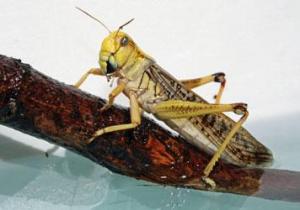There are similarities in brain disorders in insects and people with migraines, strokes and seizures. This opens up new directions for treating pharmaceuticals for these diseases.
University of Queen biologists studying grasshoppers discovered these diseases in humans linked to brain disorders, in which nerve cells stop working. This also occurs in grasshoppers when they begin the coma process after being affected by negative conditions such as high temperatures or lack of oxygen.
This study specifies insect resistance to avoid coma, and their rate of recovery, which can be applied using drugs that focus on one of the pathways. believe in brain cells.
 Biologists from Queen's University are studying on grasshoppers to find ways to affect the human brain, cure some diseases. (Photo: copyrighted by Gary Armstrong)
Biologists from Queen's University are studying on grasshoppers to find ways to affect the human brain, cure some diseases. (Photo: copyrighted by Gary Armstrong)
'This suggests that similar treatments in humans may also change the timing or severity of migraines and strokes,' said Dr. Gary Armstrong. 'What makes me feel particularly interesting is that in one of the grasshopper species, inhibiting the transmission pathway according to the set target can completely eliminate brain disorders in 70% of the samples,' advanced Dr. Robertson added.
The previous team has demonstrated that grasshopper coma is like a way to halt operations and save energy when encountering dangerous conditions. Cell reactions in grasshoppers are similar to those of brain cells when migraine attacks start.
"It should be noted that it is very difficult to drown a certain insect - because they are able to survive safely in a coma in the water for a few hours," said Armstrong. Neurological problems in humans may have the same mechanical origin as insects that survive in flood waters. '
Queen's research is published in the latest issue of the Journal of Neuroscience. Participating in this work were scientists Corinne Rodgers and Tomas Money who both worked in Dr. Robertson's laboratory. The research was funded by the Canadian Natural Science Council (NSERC).
 Why do potatoes have eyes?
Why do potatoes have eyes? 'Tragedy' the world's largest carnivorous life: Death becomes ... public toilet
'Tragedy' the world's largest carnivorous life: Death becomes ... public toilet Tomatoes were once considered 'poisonous' for 200 years
Tomatoes were once considered 'poisonous' for 200 years Detecting microscopic parasites on human face
Detecting microscopic parasites on human face Does exercising our minds a lot help us burn excess calories?
Does exercising our minds a lot help us burn excess calories?  How did Egyptian mummies remove the brain from the body?
How did Egyptian mummies remove the brain from the body?  Shocking evidence that near-death experiences are real in people who have had cardiac arrest
Shocking evidence that near-death experiences are real in people who have had cardiac arrest  AI has been able to accurately reproduce more than 80% of images in the human brain.
AI has been able to accurately reproduce more than 80% of images in the human brain.  Neuralink tests controlling a robotic arm with thoughts
Neuralink tests controlling a robotic arm with thoughts  Elon Musk's ambition to merge humans with AI
Elon Musk's ambition to merge humans with AI 